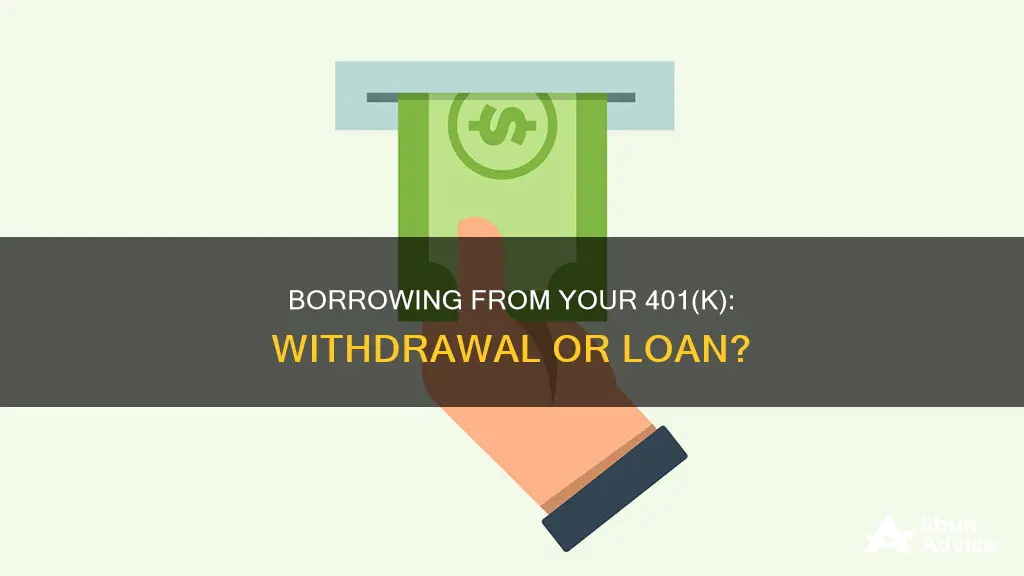
Borrowing from your 401(k) plan can be a financial lifeline in times of need, but it is important to understand the differences between a 401(k) loan and a 401(k) withdrawal. A 401(k) loan lets you borrow money from your retirement savings account, which you must pay back with interest, whereas a 401(k) withdrawal is a permanent distribution with no requirement to repay. Withdrawals may qualify as a hardship withdrawal, which is tax-exempt, or a non-hardship withdrawal, which is generally taxed as ordinary income. This article will explore the key differences between taking a loan or withdrawal from your 401(k) and the implications of each.
| Characteristics | Values |
|---|---|
| Borrowing limit | 50% of the vested account balance or $50,000, whichever is less. |
| Repayment period | 5 years or before you leave your employer. |
| Interest | Yes, and it is reinvested in your 401(k) account. |
| Credit check | No. |
| Credit score impact | No, even if you default on the loan. |
| Early withdrawal penalty | No, but if you leave your employer with an unpaid loan, it will be treated as an early withdrawal. |
| Tax | No, as long as you repay the loan on time. |
| Impact on retirement savings | Negative, as you are taking away the potential for that money to grow over time. |
| Alternatives | Personal loan, home equity line of credit, credit card with a 0% intro APR period, etc. |
What You'll Learn

Pros and cons of 401(k) loans and withdrawals
Borrowing from a 401(k) plan is not ideal, but it does have some advantages, especially when compared to an early withdrawal. Here are the pros and cons of 401(k) loans and withdrawals.
Pros of 401(k) Loans
- You can borrow up to 50% of your vested account balance or $50,000, whichever is less.
- You don't have to pay taxes and penalties when you take a 401(k) loan.
- The interest you pay on the loan goes back into your retirement plan account.
- If you miss a payment or default on your loan from a 401(k), it won't impact your credit score because defaulted loans are not reported to credit bureaus.
- You don't need to undergo a credit check to borrow from your 401(k) plan.
- You can generally borrow without it counting against your credit score.
- You can repay the loan faster without any prepayment penalty.
- You can avoid the costly expenses associated with taking an early withdrawal from your account.
Cons of 401(k) Loans
- You'll have to pay back the borrowed money, plus interest, within five years of taking your loan, in most cases.
- You may need consent from your spouse or domestic partner to take a loan.
- Your employer may limit your new contributions to your 401(k) while the loan is outstanding.
- Lower contributions could affect your ability to receive employer matches, resulting in a lower account balance than you might have had without the loan.
- You'll lose out on investing the money you borrow in a tax-advantaged account, so you'd miss out on potential growth that could amount to more than the interest you'd repay yourself.
- Withdrawing funds can impede the performance of your portfolio and the building up of your retirement nest egg.
- If you leave your current job, you might have to repay your loan in full in a very short time frame.
- If you can't repay the loan for any reason, it's considered defaulted, and you'll owe both taxes and a 10% penalty on the outstanding balance of the loan if you're under 59 1/2.
Pros of 401(k) Withdrawals
You're not required to pay back withdrawals of 401(k) assets.
Cons of 401(k) Withdrawals
- A 10% early withdrawal penalty applies on withdrawals before age 59 1/2, unless you meet one of the IRS exceptions.
- Hardship withdrawals from 401(k) accounts are generally taxed as ordinary income.
- Withdrawals can be expensive due to the taxes and penalties involved.
- Hardship withdrawals cannot be rolled back into the plan or to an IRA.
Loans and Net Worth: A Complex Relationship
You may want to see also

Hardship withdrawals
A 401(k) loan lets you borrow money from your workplace retirement account, which you must pay back with interest. However, if you are considering taking out a loan from your 401(k), it is recommended that you first exhaust all your other options for extra money. This is because, when you borrow from your retirement account, you lose the opportunity for that money to grow over time.
A hardship withdrawal, on the other hand, is a way to access your contributions early. To qualify for a hardship withdrawal, you must have what the IRS describes as an "immediate and heavy financial need", and the amount of the withdrawal must be necessary to satisfy the financial need. The IRS lists the following examples of immediate and heavy financial need:
- Medical expenses for you, your spouse, dependents, or beneficiary
- Costs directly related to the purchase of your principal residence (mortgage payments don't count)
- Payments necessary to prevent eviction or the foreclosure of your primary residence
- Certain expenses to repair damage to your principal residence
- Tuition, educational expenses, and room and board for the next 12 months of college for you or your spouse, children, dependents, or beneficiary
- Funeral expenses for you, your spouse, children, dependents, or beneficiary
Life Insurance Loan: Impact on Premium Payments?
You may want to see also

Non-hardship withdrawals
A 401(k) loan is when you borrow money from your retirement savings account. This can be a good option if you need money and have no other sources to turn to. However, it's important to keep in mind that you are borrowing from your future retirement funds, which could set you back in the long term.
In contrast to hardship withdrawals, non-hardship withdrawals can generally be repaid by rolling over the amount taken within 60 days. However, this can be a drawback as the taxes and penalties can make these withdrawals expensive. Additionally, if you have taken out a loan from your 401(k), any in-service withdrawal might be considered a taxable distribution by the IRS.
The Tax Increase Prevention Reconciliation Act (TIPRA) now permits in-service, non-hardship withdrawals before age 59 1/2. If an employer's plan permits this type of withdrawal, the employee must be eligible to take a distribution from the plan, and the funds must be eligible for a direct IRA rollover.
It's important to note that not all company-sponsored retirement plans offer in-service withdrawals, so it's best to check with your employer for the specific rules of your plan.

Borrowing limits
For example, if a participant has an account balance of $40,000, the maximum amount they can borrow from the account is $20,000. The plan's rules will also set a maximum number of loans you may have outstanding from your plan.
It is important to note that not all employer plans allow loans or withdrawals while the employee is still employed. Some employers may limit loan availability to specific purposes, such as medical or educational expenses, or for the purchase of a first home.
If you decide to take out a loan from your 401(k), it is important to consider the potential drawbacks. Firstly, you are borrowing from your retirement savings, which means you will have less money working for your retirement. Additionally, your employer may limit your contributions to your 401(k) while the loan is outstanding, affecting your ability to receive employer matches and resulting in a lower account balance. Furthermore, if you leave your job, you may have to repay the loan in full within a short time frame, and if you cannot, it is considered defaulted, and you will owe taxes and a 10% penalty if you are under 59 and a half years old.
Therefore, it is recommended to explore other options before taking a loan from your 401(k) and only use your retirement savings as a last resort.

Repayment options
First, examine your monthly budget to determine how much is left after paying other debts and household expenses. Then, decide how much you can comfortably pay each repayment period. If you have a tight budget and cannot afford the expected periodic payments, it may be a good idea to start a conversation with your employer about how you are going to pay back the loan. If the expected loan payments exceed your monthly budget, you can agree to a quarterly payment. You can then deposit the loan payments into a savings account so that you can accumulate enough money for the quarterly payments.
You can choose to pay more every month or quarter so that you can pay off the outstanding loan balance early. For example, if you are paying $500 every month, and you have money left in your budget, you can double this amount to $1000 every month until you pay off the loan. You can also round off payments to the nearest figure to reduce the repayment period. For example, if you are paying $528 every month, you can round off this payment to $600. The additional $72 payment will amount to $864, which can reduce the repayment period by one month every year.
If you receive a windfall or a large payment, you can use part of the money to settle the loan in one lump sum payment. You will need to calculate how much loan is unpaid, including any interest payments, and settle any outstanding obligations. You won’t owe any prepayment penalties for paying off the loan early.
If you are unable to keep up with the loan payments, you can decide to withdraw funds from your 401(k) to pay off the loan. You must have built an adequate balance in your 401(k) for the withdrawal to be approved. A 401(k) withdrawal is permanent, and you won’t be required to pay back the money. Hence, once you use the funds to pay off the unpaid loan, you won’t have further obligations. However, if you are below age 59 1/2, you will be required to pay taxes and penalties on the amount withdrawn.
If you plan to leave your job, and you have an active 401(k) loan, you should work out a plan to pay the loan balance before you leave. You can increase the loan payments or offer to clear the loan with a lump sum payment before you leave. Usually, leaving a job with an unpaid loan means you will have to pay back the full loan amount within a shorter period, usually before the tax due date for federal tax returns.
The maximum repayment period for a general-purpose loan is five years, although it can be longer for residential loans. For a 401(k) residential loan, borrowers can only use the money to purchase a primary residence. Employees must submit supporting documents, such as a purchase and sales agreement. Residential loans often provide longer repayment terms compared to general-purpose loans but must be limited to what a reasonable mortgage length would be.
If you had a 401(k) loan balance and left your employer, you will have until the following year's tax due date to repay the loan to avoid default and any tax penalty for early withdrawal.
Frequently asked questions
No, taking a loan from a 401(k) does not count as a withdrawal. With a 401(k) loan, you borrow money from your retirement savings account with the intention of paying it back, whereas with a withdrawal, you simply take money out of your retirement savings with no requirement to pay it back.
Some pros of taking a loan from a 401(k) include:
- You don't have to pay taxes and penalties when you take the loan, unlike with a withdrawal.
- You don't need to undergo a credit check.
- The interest you pay on the loan will go back into your retirement account.
Some cons of taking a loan from a 401(k) include:
- You are depleting the money you are saving and investing for your future.
- You have to pay back the loan, which can be difficult if you are also trying to keep up with regular contributions.
- Your employer may limit your new contributions to your 401(k) while the loan is outstanding.
A hardship withdrawal is a type of withdrawal from your 401(k) that is permitted only in cases of immediate and heavy financial need, such as medical expenses, funeral expenses, or tuition payments. Hardship withdrawals cannot be repaid, but they also do not come with the taxes and penalties associated with regular withdrawals.
Some alternatives to taking a loan from a 401(k) include:
- Using your savings or emergency cash.
- Taking out a personal loan.
- Taking out a home equity line of credit (HELOC).







